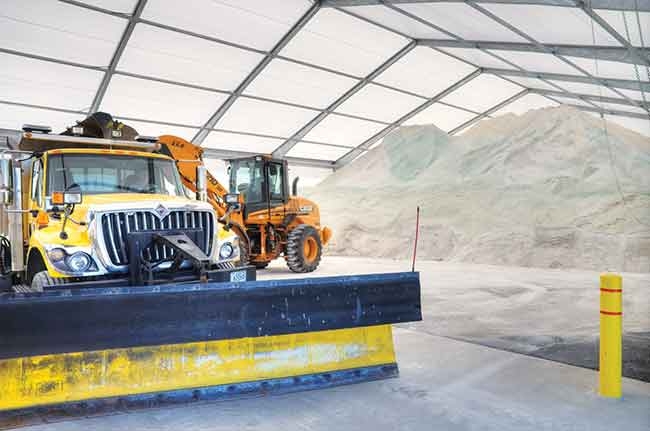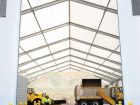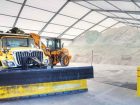
News
Under cover
Best practices for choosing salt storage structures
October 13, 2016 By Jim Kumpula
 Buildings must be durable to withstand any impact from spreaders and trucks.
Buildings must be durable to withstand any impact from spreaders and trucks. As the winter maintenance season approaches, contractors who stockpile their own de-icing material may be assessing their needs for salt storage. Whether your current facility simply needs repair or a whole building replacement is in order, there are several options to evaluate.
Salt storage buildings actually serve two functions: one is to contain the chemical, and the other is to shield the environment from the salt. Different structures offer varying degrees of both of these protections:
- Tarps. The most basic approach, covering salt piles with tarps, may be especially tempting to those faced with tight budgets. In fact, it is commonly used, particularly by facilities that store large amounts of salt. But there is a significant risk to this model. The waterproof covers are vulnerable to tearing during the handling process, leaving salt exposed to wind and moisture.
- Silos. The vertical orientation of silo-type storage may appeal to operations that have limited lot or yard size, but the mechanical systems of these gravity-fed units can be prone to jamming, owing to the tendency of salt to cake and clump over time. The capacity of these silos is limited, making them impractical choices for locations where large amounts of salt must be stored.
- Timber-framed buildings. Wood structures are durable and strong, but need diligent maintenance, whether they are clad in corrosion-prone metal panels or in wooden siding, which must be painted regularly to stave off decay. They are costly to construct, particularly if the structure is large and requires long-span lumber. The construction process is labour-intensive, and can be slow, depending on the intricacy of the design.
- Fabric structures. Tension fabric salt-storage buildings deliver enhanced value because they offer a number of advantages compared to other storage designs. They can be installed quickly, often in a couple of weeks. Most corrosive materials have no impact on the scrim and coatings used to create the architectural fabric that wraps the building. Because the fabric is translucent, it can channel natural light into the structure, lessening the need, and the cost, for conventional light fixtures. Their modular, customizable structure allows them to be responsive to the changing needs of the business. It is a simple process to add a lean-to structure, eave extensions, or roof-mounted ice breakers to the design.
Durability and maintenance
Salt handling is a rough-and-tumble business, and storage sheds are subject to being bumped by spreaders, trucks and other vehicles. Placing bollards around the vulnerable points on the exterior of a building can guard the building. In addition to exterior corners, door jambs and lintels are prime targets for impact damage. Door openings can be wrapped to deflect and cushion any accidental collisions made by vehicles or equipment.
Combating corrosion
Of all the building performance issues faced by salt handlers, storage facility corrosion can be one of the most damaging. Left unchecked, it can add to maintenance costs, shorten the structure’s lifespan and even put employees and equipment at risk. Constructing a fabric building with a rigid steel frame solves several problems traditionally associated with fabric structures that rely on lightweight aluminum trusses.
Unlike open trusses, with hollow tube cords and webs, rigid steel frames have no opportunity to corrode from the inside out because they are composed of solid steel plates. The frames can be hot-dip galvanized, a process where a zinc coating is electrochemically applied to the steel through a series of chemical baths.
Hot dip galvanizing adheres a minimum of 3.9 mils of zinc to all inside and outside surfaces of the steel after manufacturing, providing maximum protection from corrosion. The frames can support a fabric liner on the interior of the building, between the salt piles and the steel frame, which adds an extra physical barrier against corrosive elements.
Rigid steel frames can also be engineered to support handing loads: for instance, overhead conveyors and fire suppression systems as well as seismic, snow and wind dynamic loads.
Whatever storage facility you choose, it must fully comply with local building and environmental codes. Working with a licensed architect who is knowledgeable about regulations, suppliers and standards will guarantee your next salt storage structure will serve your needs and interests well.
What to know before choosing
To choose the storage facility that is right for your needs, it’s important to take stock of environmental and site conditions, as well as the required performance of the building. Here are some fundamental considerations that impact the design of storage structures:
- Building contents. Are you storing corrosive or inert material? If it’s the latter, many suitable storage facility choices are available. If it’s the former, look at buildings constructed of corrosion-resistant materials, both for their framing and their cladding.
- Handling conditions. Does the stored material need to be a climate-controlled space? Passive ventilation systems, such as louvered openings, are economical solutions that virtually all buildings can accommodate. Mechanical HVAC systems offer more control, but because of their weight they can be challenging to install in some types of structures.
- Permanent or portable. If it’s possible that your storage structure will be relocated, be proactive and research the portability of building types. Certain foundation designs, such as precast concrete panels, offer this kind of flexibility.
- Accessibility. Consider the delivery requirements of your facility. Do trucks or front-end loaders need access to the interior of the building, or is the off-loading process handled externally? It’s easier and safer to engineer doors and openings into straight sidewalls, rather than curved walls.
- Snow load. Smooth-surfaced, sloping roofs inherently relieve snow loads, but a building’s structural frame must still be engineered to provide sufficient strength to withstand the weight. Low-pitched and flat roofs are particularly vulnerable to snow accumulation.
- Wind exposure. The terrain surrounding a specific site can influence the wind pressure on a building. Care must be taken to sufficiently secure the building’s frame to the foundation. Another wind-related concern: the storage facility must be oriented so that truck-loading operations are shielded as much as possible from prevailing winds to minimize salt blowing around the site, as this can pollute the environment and increase the likelihood of corrosion in equipment and unprotected metal structural elements.
Jim Kumpula is general manager (Canada) for Legacy Building Solutions. Based in South Haven, MN, Legacy Building Solutions (www.legacybuildingsolutions.com) designs, manufactures, engineers and installs custom rigid-steel-frame tension fabric storage structures.
Print this page

